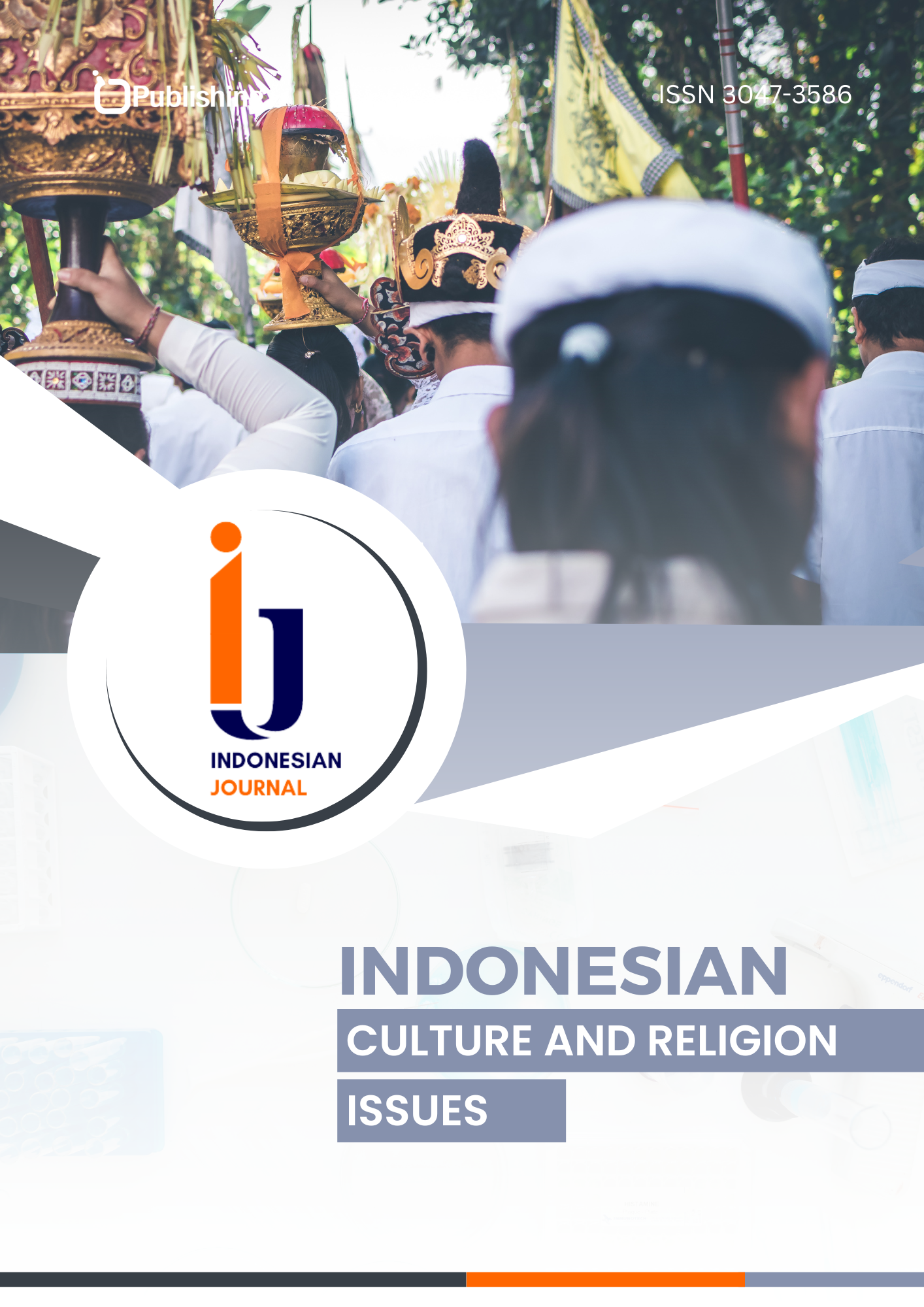Kajian Wacana Budaya dalam Media Cetak Era Reformasi
DOI:
https://doi.org/10.47134/diksima.v2i3.216Keywords:
Budaya, Cetak, Narasi, Reformasi, WacanaAbstract
Penelitian ini bertujuan untuk menganalisis bagaimana wacana budaya dikonstruksi dan direpresentasikan dalam media cetak Indonesia pasca-reformasi, dengan fokus pada strategi bahasa dan narasi yang digunakan media dalam membingkai isu budaya, serta hubungan antara perubahan sosial-politik dan peran media cetak sebagai agen pembentuk ideologi. Pendekatan kualitatif dengan metode analisis wacana kritis (CDA) digunakan untuk mengkaji wacana budaya yang dibentuk media cetak antara tahun 1998 dan periode tertentu, dengan data utama berasal dari artikel, berita, dan opini yang diterbitkan oleh media nasional seperti Kompas, Media Indonesia, dan Republika. Hasil penelitian menunjukkan bahwa media cetak pasca-reformasi mengubah wacana budaya dengan mendorong diskusi publik yang lebih inklusif, menggantikan narasi teologis dan memperkenalkan representasi budaya yang lebih beragam, termasuk pengakuan terhadap budaya Tionghoa Indonesia. Di sisi lain, tantangan seperti komersialisasi media dan stereotip yang terus berlanjut menunjukkan ketegangan antara keberagaman budaya dan homogenisasi budaya dalam media. Media cetak berperan dalam membentuk identitas budaya dengan memanfaatkan metafora, simbol, dan narasi, namun juga berisiko memperkuat bias dan stereotip, sehingga menuntut keterlibatan kritis dalam membaca wacana media untuk menciptakan pemahaman budaya yang lebih inklusif.
References
(Thinley, 2007). (n.d.). Cultural Maintenance and Promotion: The Print Media’s Role in Providing Space for Knowledge and Discourse. https://doi.org/https://doi.org/10.11588/XAREP.00000342
Al-Badri, L. (2023). The Media’s Role in Transmitting Cultural Dialogue. Academic International Journal of Social Sciences and Humanities, 1(1), 17–21. https://doi.org/10.59675/S112
Appel, C. (2022). Books, Education, and the Contours of a Lutheran Reading Culture. Post-Reformation Denmark (c. 1530–1700). In Reformation and Education (pp. 61–108). Vandenhoeck & Ruprecht. https://doi.org/10.13109/9783666560552.61
Arshad, H., & Batool, S. (2023). Role of Print Media in Reporting Conflicts Between India and Pakistan: A Comparative Analysis of Pakistani and Indian English Dailies (Jan 2016_Feb 2019). Global Digital & Print Media Review, VI(I), 298–312. https://doi.org/10.31703/gdpmr.2023(VI-I).24
Awad Cherit, I. (2008). Cultural Diversity in the News Media: A Democratic or a Commercial Need? Javnost - The Public, 15(4), 55–72. https://doi.org/10.1080/13183222.2008.11008982
Bagchi, D. (2016). Printing, Propaganda, and Public Opinion in the Age of Martin Luther. In Oxford Research Encyclopedia of Religion. Oxford University Press. https://doi.org/10.1093/acrefore/9780199340378.013.269
Baig, F. Z., Aslam, M. Z., Akram, N., Fatima, K., Malik, A., & Iqbal, Z. (2020). Role of Media in Representation of Sociocultural Ideologies in Aurat March (2019–2020): A Multimodal Discourse Analysis. International Journal of English Linguistics, 10(2), 414. https://doi.org/10.5539/ijel.v10n2p414
BAYRAK, B. (2018). MEDIA DISCOURSE, IDEOLOGY AND PRINT MEDIA IN TURKEY. Electronic Journal of New Media, 2(2), 53–62. https://doi.org/10.17932/IAU.EJNM.25480200.2018.2/2.53-62
Berger, A. (2024). Mediating Change: Pamphilus Gengenbach, Print Culture, and the Vernacular in Early Reformation Basel. Religions, 15(11), 1329. https://doi.org/10.3390/rel15111329
Brinker, F., & Mayer, R. (2023). Modernity and the Periodical Press. BRILL. https://doi.org/10.1163/9789004468269
Burgers, C., Konijn, E. A., & Steen, G. J. (2016). Figurative Framing: Shaping Public Discourse Through Metaphor, Hyperbole, and Irony. Communication Theory, 26(4), 410–430. https://doi.org/10.1111/comt.12096
Bushra Amin, Dr. Shafaq Fayyaz, & Dr. Saqib Mahmood. (2024). Exploring the Discursive Representation of Pakistani Female Politicians in Print and Electronic Media: A Qualitative Study of Narrative and Framing. EVOLUTIONARY STUDIES IN IMAGINATIVE CULTURE, 1533–1546. https://doi.org/10.70082/esiculture.vi.1566
Cádima, F. R. (2017). Media, diversity and globalisation in the digital age. JANUS.NET, e-Journal of International Relation, 8(2). https://doi.org/10.26619/1647-7251.8.2.7
Chen, X. (2007). Media Lens Revisited: Television and Socio-Political Changes in China. Journal of Chinese Political Science, 12(2), 167–184. https://doi.org/10.1007/s11366-007-9006-2
Dekavalla, M., & Montagut, M. (2018). Constructing issues in the media through metaphoric frame networks. Discourse, Context & Media, 26, 74–81. https://doi.org/10.1016/j.dcm.2018.05.003
Diesen, G. (2022). Language and Strategic Narratives: Imparting Legitimacy. In Russophobia (pp. 115–143). Springer Nature Singapore. https://doi.org/10.1007/978-981-19-1468-3_5
Earl, C. (2013). Saigon Style: Middle-Class Culture and Transformations of Urban Lifestyling in Post-Reform Vietnamese Media. Media International Australia, 147(1), 85–97. https://doi.org/10.1177/1329878X1314700110
Eddyono, S. (2018). The representations of Indonesianness in post-new order Indonesia (1998-2016). University of Pittsburgh.
Fakih, A. (2024). Media Under the Law: Press Freedom Challenges in Indonesia. Indonesia Media Law Review, 3(1). https://doi.org/10.15294/imrev.v3i1.78900
Glasser, T. L., Awad, I., & Kim, J. W. (2009). The Claims of Multiculturalism and Journalism’s Promise of Diversity. Journal of Communication, 59(1), 57–78. https://doi.org/10.1111/j.1460-2466.2008.01404.x
Hasan, K. (2023). Political Discourse and Ideology: A Semiological Discourse Analysis of Pakistani Urdu and English Newspapers. Annals of Human and Social Sciences, 4(II). https://doi.org/10.35484/ahss.2023(4-II)05
Hout, T. Van, & Cotter, C. (2015). Print Media Discourse. In The International Encyclopedia of Language and Social Interaction (pp. 1–6). Wiley. https://doi.org/10.1002/9781118611463.wbielsi187
Isakhan, B. (n.d.). Iraq’s December 2005 election : reporting democratisation in the Australian and Middle Eastern print media.
Jacobs, R. N. (1996). Civil Society and Crisis: Culture, Discourse, and the Rodney King Beating. American Journal of Sociology, 101(5), 1238–1272. https://doi.org/10.1086/230822
Jamil, S., & Retis, J. (2023). Media Discourses and Representation of Marginalized Communities in Multicultural Societies. Journalism Practice, 17(1), 1–4. https://doi.org/10.1080/17512786.2022.2142839
Kabataikyzy, A. (2024). Metaphor as a Means of Expression in the Media. Bulletin of Science and Practice, 10(10), 481–485. https://doi.org/10.33619/2414-2948/107/62
Kasiyan Kasiyan. (n.d.). HEGEMONI ESTETIKA POSTCOLONIAL DALAM REPRESENTASI IKLAN Dl MEDIA MASSA CETAK INDONESIA KONTEMPORER. https://doi.org/https://doi.org/10.22146/JH.V24I3.1371
Lai, C. P. (n.d.). Cite Paper - Media in Hong Kong: Press Freedom and Political Change, 1967-2005.
Landau, M. J., & Keefer, L. A. (2014). This Is Like That: Metaphors in Public Discourse Shape Attitudes. Social and Personality Psychology Compass, 8(8), 463–473. https://doi.org/10.1111/spc3.12125
McLachlin, D. (n.d.). “For All the Women You Are”: National Identity, Gender, and Tradition/Modernity in Indian Women’s Magazines.
Melati, Nurdin, M., & Putri, V. A. (2024). Media Under the Law: Press Freedom Challenges in Indonesia. Research Review: Jurnal Ilmiah Multidisiplin, 3(1), 133–140. https://doi.org/10.54923/researchreview.v3i1.82
Melissa, E. (2017). Representasi Warga Tionghoa dan Kecinaan dalam Media Kontemporer Indonesia. Jurnal Komunikasi Indonesia, 2(1). https://doi.org/10.7454/jki.v2i1.7826
Mickiewicz, E. (1997). The Media Market: Politics, Commerce, and Press Freedom. In Changing Channels (pp. 217–241). Oxford University PressNew York, NY. https://doi.org/10.1093/oso/9780195101638.003.0010
Morgan, D. (1999). Talking Pictures. In Protestants & Pictures Religion, Visual Culture, and the Age of American Mass Production (pp. 235–262). Oxford University PressNew York, NY. https://doi.org/10.1093/oso/9780195130294.003.0008
Nguyen-Thu, G. (n.d.). Television in Post-Reform Vietnam: Nation, Media, Market.
Nwaolikpe, O. N. (2013). Culture and Nigerian Identity in the Print Media. Oman Chapter of Arabian Journal of Business and Management Review, 3(3), 63–71. https://doi.org/10.12816/0016431
O’Grady, T. (2022). Discourse in the Print Media. In The Transformation of British Welfare Policy (pp. 154–188). Oxford University Press. https://doi.org/10.1093/oso/9780192898890.003.0005
Pettegree, A. (2017). The Reformation as a Media Event. Archiv Für Reformationsgeschichte - Archive for Reformation History, 108(1), 126–133. https://doi.org/10.14315/arg-2017-0115
Poti, J., & Khairie Ahmad, M. (2021). Mass Media Reform and Democratization in the Indonesian Context. Social Sciences, 10(1), 28. https://doi.org/10.11648/j.ss.20211001.14
Price, M. E. (1996). National and Post-National Identity. In Television (pp. 40–59). Oxford University PressOxford. https://doi.org/10.1093/oso/9780198183624.003.0003
Purwanto, M. R., Praya, P., Damaiyanie, D. A., Fadilah, F. R., & Purwanto, E. (2020). Dinamika Komunikasi Pembangunan di Era Globalisasi. Interaction Communication Studies Journal, 1(4), 10. https://doi.org/10.47134/interaction.v1i4.3513
Sagayaselvi, G., Asmi, R. R., Kurugnanagowtham, K., Surya, S., Gokila, V., Kumar, R. N., Palanisamy, S. A., & S, Y. P. (2024). Exploring the Intersection of Tradition and Modernity: Perception of Ideas and Ideology in Chitra Banerjee Divakaruni’s Novels. International Journal of Language, Literature and Culture, 4(6), 47–50. https://doi.org/10.22161/ijllc.4.6.7
Sahrasad, H. (2014). Pers, demokrasi dan negara Indonesia Post-Soeharto: Sebuah perspektif. Masyarakat, Kebudayaan Dan Politik, 27(1), 27. https://doi.org/10.20473/mkp.V27I12014.27-43
Salih, R. (n.d.). The Gender of Modernity: Narratives of Muslim and Islamist Migrant Women.
Sharova, A. A. (2022). Metaphorical image of modern Russian culture in the American press. Verhnevolzhski Philological Bulletin, 1(28), 140–145. https://doi.org/10.20323/2499-9679-2022-1-28-140-145
Sidorova, I. G. (2023). The Brand of Wellness: Linguistic Representation of this Phenomenon in the Mass Media Discourse. Current Issues in Philology and Pedagogical Linguistics, 2, 177–189. https://doi.org/10.29025/2079-6021-2023-2-177-189
The Language of Crisis: Print Media’s Re[presentation] of the Covid-19 Discourses through Linguistic Choices. (2023). Research on Humanities and Social Sciences. https://doi.org/10.7176/RHSS/13-10-07
van Dijk, T. A. (2006). Politics, Ideology, and Discourse. In Encyclopedia of Language & Linguistics (pp. 728–740). Elsevier. https://doi.org/10.1016/B0-08-044854-2/00722-7
Walsham, A. (2000). “DOMME PREACHERS”? POST-REFORMATION ENGLISH CATHOLICISM AND THE CULTURE OF PRINT. Past & Present, 168(1), 72–123. https://doi.org/10.1093/past/168.1.72
Wilson, P., & Stewart, M. (Eds.). (2008). Global Indigenous Media. Duke University Press. https://doi.org/10.1215/9780822388692
Wiratraman, H. P. (1959). Press freedom, law and politics in Indonesia: a socio-legal study. Transition, 1956, 34.
Zayani, M. (n.d.). Media, cultural diversity and globalization: challenges and opportunities.
Downloads
Published
How to Cite
Issue
Section
License
Copyright (c) 2025 Muhammad Nasril Ilham, Muhammad Dzaky Ramadhani, Revaldi Bagus Pamungkas, Fadhlika Angkasa, Eko Purwanto

This work is licensed under a Creative Commons Attribution 4.0 International License.










